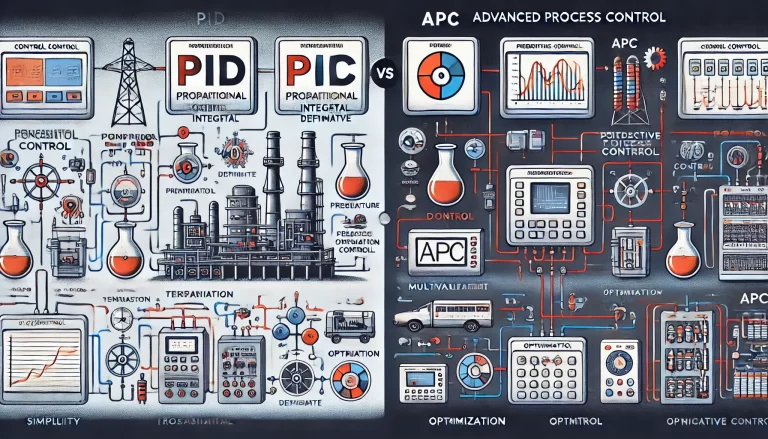Introduction
PID (Proportional-Integral-Derivative) controllers are essential tools in process control engineering, yet their importance is often underestimated. Why should companies invest in PID tuning? The answer lies in their significant impact on safety, efficiency, and profitability. Proper tuning ensures that controllers match the specific dynamics of a process, making it a critical skill for engineers.
This article explores the growing complexity of process control, the cost-saving potential of proper loop tuning, and a real-world refinery case study that highlights the immense value PID tuning brings to industrial operations.
1. The Growing Complexity of Process Control
In the past, process operators typically monitored 100–200 PID controllers, often without advanced process control (APC) systems to assist them. Safety systems, if present, were typically located on-site, and key functions such as surge control for compressors relied on dedicated, locally installed equipment. Under such conditions, operators could maintain control with fewer tools and simpler systems.
Modern Challenges
Today’s process operators manage significantly more complexity. A single operator might oversee up to 500 PID controllers in addition to safety systems, compressor controls, and APC applications. The control systems themselves are also more sophisticated, with multi-level cascade loops and complex logic designs.
Despite advances in control technology, such as better graphical interfaces and reduced alarm clutter, these tools are not enough on their own. Poorly tuned controllers cannot be ignored. If 30% of controllers in a system perform suboptimally, operators face overwhelming challenges, especially as the number of controllers grows.
In this environment, ensuring well-tuned controllers becomes essential. A system with well-tuned controllers allows operators to focus on critical issues rather than managing inefficiencies, ultimately enhancing both operational safety and efficiency.

2. Cost Savings Through Proper Loop Tuning
In most chemical processes, maximum profitability is achieved when operations are run close to constraints such as product quality limits, equipment capacity, and safety thresholds. When PID controllers are poorly tuned, operators often maintain processes well below these constraints to avoid potential violations, leading to lost profit opportunities.
Understanding the Impact
A poorly tuned system typically exhibits significant variability, as illustrated in Figure 1 (hypothetical). The bell curve representing process data shows a wide spread, with the average operating point far from the theoretical maximum profit zone. This gap between the average operating point and the profit-maximizing zone represents unrealized potential.
Improving Profitability
Effective PID tuning reduces variability, “squeezing” the bell curve, and enables operations to shift closer to the constraint limits without exceeding them. The result is a tighter distribution of process data, as shown in Figure 2, where the average operating point aligns more closely with the profit-maximizing zone. This shift not only boosts profitability but also improves operational stability and reduces waste.
However, convincing operators to push constraints remains a challenge. Operators may resist changes that appear to increase their workload or risk. Engineers must demonstrate that proper tuning can simplify operations or at least maintain current levels of effort while delivering significant benefits. Building trust through open communication and showcasing previous successes is key to overcoming resistance.

3. Case Study: Refinery PID Tuning Brings Golden Results
A former colleague once told me, “Refineries are littered with gold; you just have to know where to look.” This perspective reflects the immense untapped potential in refining processes. One example comes from a refinery where PID tuning contributed to a dramatic improvement in profitability.
The Problem
For years, the refinery’s Fluidized Catalytic Cracking (FCC) unit struggled with inefficiencies. The vice president persistently requested a new wet gas compressor to handle the unit’s demands. However, instead of immediately investing in expensive new equipment, our team focused on improving the control systems.
The Solution
Our work included:
- Cleaning and tuning existing PID controllers.
- Repairing faulty instruments and valves.
- Implementing advanced process control (APC) systems.
- Educating operators and building trust to push process constraints.
Over time, these improvements allowed the FCC unit to increase feed rates by approximately 20%. This increase was achieved without the need for a costly new compressor. When the vice president finally reviewed the results, he remarked proudly, “Look, I saved money for the company!”
Wider Implications
This success was not isolated. Across the refinery, similar initiatives led to substantial gains, reinforcing the importance of PID tuning as a cornerstone of process improvement.

Conclusion and Future Outlook
As process complexity grows, the role of PID tuning becomes even more critical. Properly tuned controllers reduce variability, improve safety, and unlock profitability by allowing operations to approach critical constraints without exceeding them.
Looking ahead, the integration of artificial intelligence (AI) and machine learning in process control promises even greater opportunities. These technologies could automate tuning processes, identify inefficiencies, and optimize performance in real time, ensuring that the benefits of PID tuning continue to expand.
Investing in PID tuning is more than a technical decision—it is a strategic move toward safer, more efficient, and more profitable operations. The question isn’t whether to tune your PID controllers; it’s how soon you can start.
